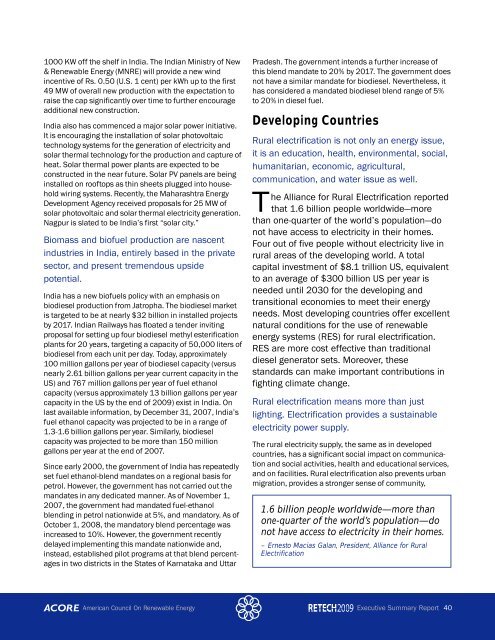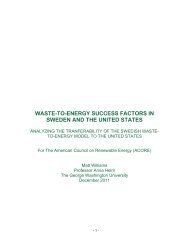1000 KW off the shelf in India. The Indian Ministry of New& <strong>Renewable</strong> <strong>Energy</strong> (MNRE) will provide a new windincentive of Rs. 0.50 (U.S. 1 cent) per kWh up to the first49 MW of overall new production with the expectation toraise the cap significantly over time to further encourageadditional new construction.India also has commenced a major solar power initiative.It is encouraging the installation of solar photovoltaictechnology systems for the generation of electricity andsolar thermal technology for the production and capture ofheat. Solar thermal power plants are expected to beconstructed in the near future. Solar PV panels are beinginstalled on rooftops as thin sheets plugged into householdwiring systems. Recently, the Maharashtra <strong>Energy</strong>Development Agency received proposals for 25 MW ofsolar photovoltaic and solar thermal electricity generation.Nagpur is slated to be India’s first “solar city.”Biomass and biofuel production are nascentindustries in India, entirely based in the privatesector, and present tremendous upsidepotential.India has a new biofuels policy with an emphasis onbiodiesel production from Jatropha. The biodiesel marketis targeted to be at nearly $32 billion in installed projectsby 2017. Indian Railways has floated a tender invitingproposal for setting up four biodiesel methyl esterificationplants for 20 years, targeting a capacity of 50,000 liters ofbiodiesel from each unit per day. Today, approximately100 million gallons per year of biodiesel capacity (versusnearly 2.61 billion gallons per year current capacity in theUS) and 767 million gallons per year of fuel ethanolcapacity (versus approximately 13 billion gallons per yearcapacity in the US by the end of 2009) exist in India. <strong>On</strong>last available information, by December 31, 2007, India’sfuel ethanol capacity was projected to be in a range of1.3-1.6 billion gallons per year. Similarly, biodieselcapacity was projected to be more than 150 milliongallons per year at the end of 2007.Since early 2000, the government of India has repeatedlyset fuel ethanol-blend mandates on a regional basis forpetrol. However, the government has not carried out themandates in any dedicated manner. As of November 1,2007, the government had mandated fuel-ethanolblending in petrol nationwide at 5%, and mandatory. As ofOctober 1, 2008, the mandatory blend percentage wasincreased to 10%. However, the government recentlydelayed implementing this mandate nationwide and,instead, established pilot programs at that blend percentagesin two districts in the States of Karnataka and UttarPradesh. The government intends a further increase ofthis blend mandate to 20% by 2017. The government doesnot have a similar mandate for biodiesel. Nevertheless, ithas considered a mandated biodiesel blend range of 5%to 20% in diesel fuel.Developing CountriesRural electrification is not only an energy issue,it is an education, health, environmental, social,humanitarian, economic, agricultural,communication, and water issue as well.The Alliance for Rural Electrification reportedthat 1.6 billion people worldwide—morethan one-quarter of the world’s population—donot have access to electricity in their homes.Four out of five people without electricity live inrural areas of the developing world. A totalcapital investment of $8.1 trillion US, equivalentto an average of $300 billion US per year isneeded until 2030 for the developing andtransitional economies to meet their energyneeds. Most developing countries offer excellentnatural conditions for the use of renewableenergy systems (RES) for rural electrification.RES are more cost effective than traditionaldiesel generator sets. <strong>More</strong>over, thesestandards can make important contributions infighting climate change.Rural electrification means more than justlighting. Electrification provides a sustainableelectricity power supply.The rural electricity supply, the same as in developedcountries, has a significant social impact on communicationand social activities, health and educational services,and on facilities. Rural electrification also prevents urbanmigration, provides a stronger sense of community,1.6 billion people worldwide—more thanone-quarter of the world’s population—donot have access to electricity in their homes.– Ernesto Macias Galan, President, Alliance for RuralElectrification<strong>American</strong> <strong>Council</strong> <strong>On</strong> <strong>Renewable</strong> <strong>Energy</strong>Executive Summary Report 40
educes mortality and improves gender equality. Electricityhas also a substantial impact in terms of economic developmentby increasing productivity and economic growth.World electricity demand is expected to doublebetween now and 2030.Most of the growth of the world’s electricity demand isoccurring in developing countries, where electrificationrates are not keeping up with population growth. There are2.5 billion people who rely on traditional biomass as theirprincipal source of energy. This has terrible consequenceson land use and degradation, but also on human health.Indoor air pollution is directly responsible for 1.3 milliondeaths per year. The cost of fossil-fuel imports is unbearablefor many developing countries. Sudden price increasescause economic interference and can disrupteconomic growth. In many less developed countries, alarge percentage of export earnings (i.e., up to 40 percentin Nepal) are diverted to pay for the importation ofpetroleum fuels.Off-grid power generation is often the bestsolution for bringing an electricity supply torural areas.Due to low potential electricity demand, and severephysical limitations, grid extension is often not a feasibleoption. According to the International <strong>Energy</strong> Agency, thefigures regarding access to energy will remain largelyunchanged in 2015 unless new strategies are adopted toexpand access to modern services. Therefore, newapproaches are needed to increase the production ofelectricity in rural areas, and to improve local livingstandards. <strong>On</strong>e of the best solutions is a hybrid off-gridpower system. This type of system offers the followingbenefits:• Higher flexibility by coupling all consumers andgenerators on AC (alternative current)transmission line,• Standard AC used technology in the powerrange above several kilowatts,• Different local renewable and conventionalenergy sources are suitable to form a hybrid grid,• Simple expandability,• Extension of an existing diesel based powersystem, and• Use as a backup solution for unstable public grids.A number of opportunities arise in the processof rural electrification.Opportunities from rural electrification include stimulatingfurther investments from the private sector, promotingwin-win situations between all stakeholders involved(foreign industry, local industry, users, local installers anddistributors), fostering economic development through thegeneration of wealth and employment, and increasingelectrification rates in a sustainable way.Solar power is an excellent option for energygeneration in developing countries.Photovoltaics and solar thermal systems have manyapplications in remote and rural areas because thetechnology has no moving parts, generates electricity thatcan be used immediately or stored in batteries, and doesnot depend on the reliability of the grid infrastructure, oron the fluctuating price of oil. Solar power in developingcountries creates opportunities for water pumping andpurification, electrification of rural schools and clinics,microenterprise, household and community lighting, andwireless internet.International Climate and<strong>Energy</strong> PolicyInternational attention, appeal, and collaborationis being garnered by investments in cleantechnology and renewable energy projects.At the 2008 Investor Summit on Climate Risk atthe United Nations, signatories of the Summit’sAction Plan agreed to a total investment of $1.75trillion. The action plan initiated the deployment of$10 billion immediately to start mitigating theeffects of climate change. The action plan alsocalled for other measures, including improvingenergy performance of real estate portfolios andinvestments, bettering corporate disclosure offinancial and material risks posed by climatechange, requiring investment managers to assessclimate in portfolios, and factoring in carbon costsinto valuations and investment analysis. Cleantechnology and renewable energy are viable solutionsto the headline issues that will be raised atboth COP 15 Conference in December 2009 and the2010 Investor Summit at the United Nations.<strong>American</strong> <strong>Council</strong> <strong>On</strong> <strong>Renewable</strong> <strong>Energy</strong>Executive Summary Report 41
- Page 6: The highlights of WIREC 2008 includ
- Page 9 and 10: EVENT SPONSORSHosted byBadge Sponso
- Page 11 and 12: EXHIBITORS ContinuedKamatics Corp.K
- Page 13 and 14: The ARRA contains the following ite
- Page 15 and 16: “How do we organize ourselves to
- Page 17 and 18: John GeesmanFormer Commissioner, Ca
- Page 19 and 20: Cathy ZoiCEO, Alliance for Climate
- Page 21 and 22: John CavalierManaging Partner, Huds
- Page 23 and 24: BiofuelsChristopher Groobey, Partne
- Page 25 and 26: Patrick Cloney, Executive Director,
- Page 27 and 28: Gal Luft, Executive Director, Insti
- Page 29 and 30: Daniel Kammen, Class of 1935 Distin
- Page 31 and 32: Biomass, Biofuels, and Advanced Veh
- Page 33 and 34: Critical development opportunities
- Page 35 and 36: ConclusionsSpeakers at RETECH 2009
- Page 37 and 38: Geothermal PowerOverviewThe United
- Page 39 and 40: Green Buildings and CommunitiesOver
- Page 41 and 42: Green construction and renovation s
- Page 43 and 44: Session ReferencesGreen Schools Bre
- Page 45 and 46: 1. The local electric power market
- Page 47 and 48: International Renewable Energy Indu
- Page 49 and 50: production was 37%; the domestic tu
- Page 51: There have been a number of incenti
- Page 55 and 56: D7 - ChinaJing Su, Director of US-C
- Page 57 and 58: past, uncertain legislative environ
- Page 59 and 60: marketplace, accelerating and deepe
- Page 61 and 62: • Complexity and operating costs
- Page 63 and 64: C6 - Environmental and Carbon Finan
- Page 65 and 66: The technology debate: thin film ve
- Page 67 and 68: FITs have grown in popularity over
- Page 69 and 70: Haroula Reitz, Global Manager of Sc
- Page 71 and 72: Currently, planning is geographical
- Page 73 and 74: Federal policy should allow for a c
- Page 75 and 76: Wind: Markets, Technologies, and Po
- Page 77 and 78: Regional FactorsBesides federal pol













